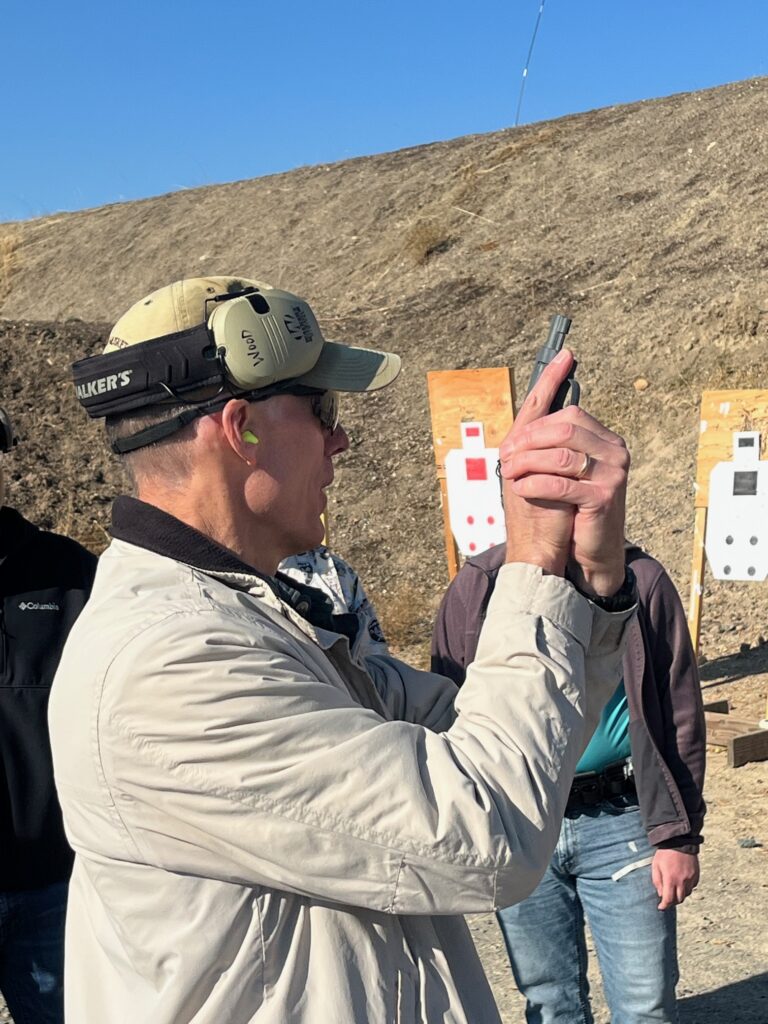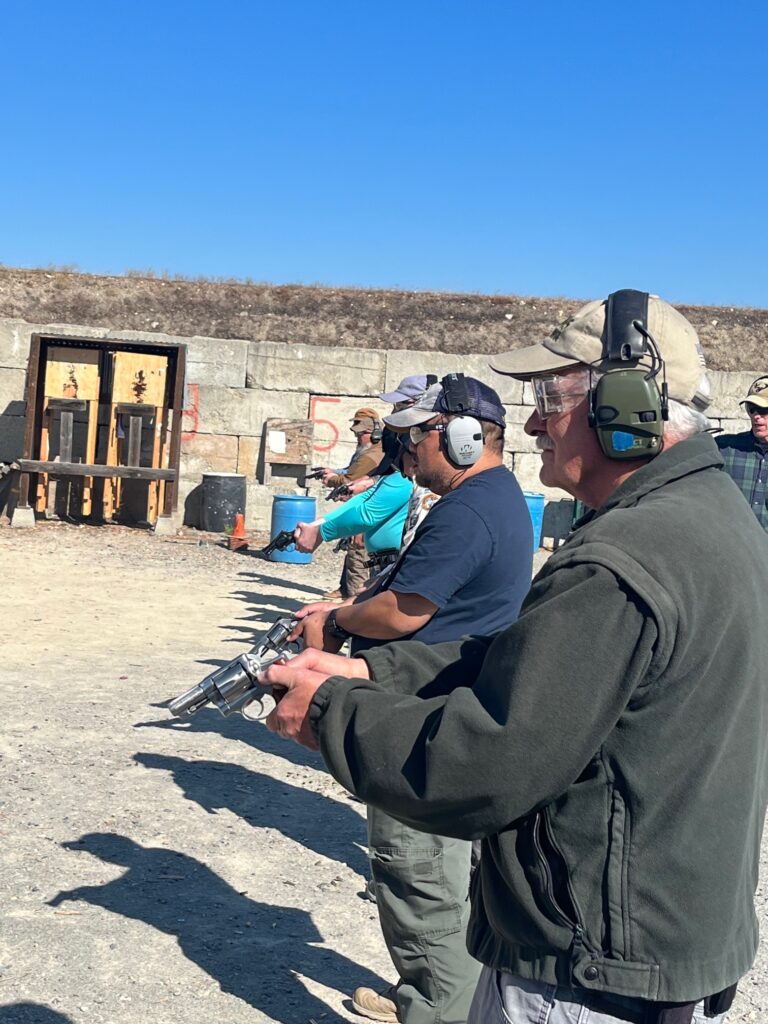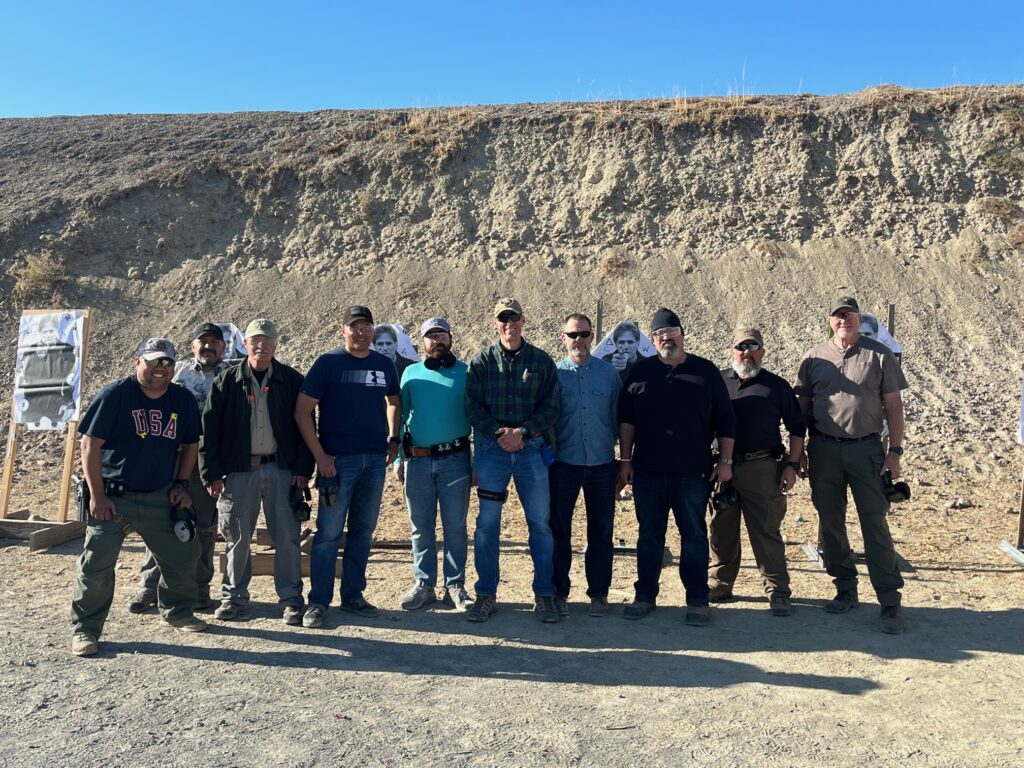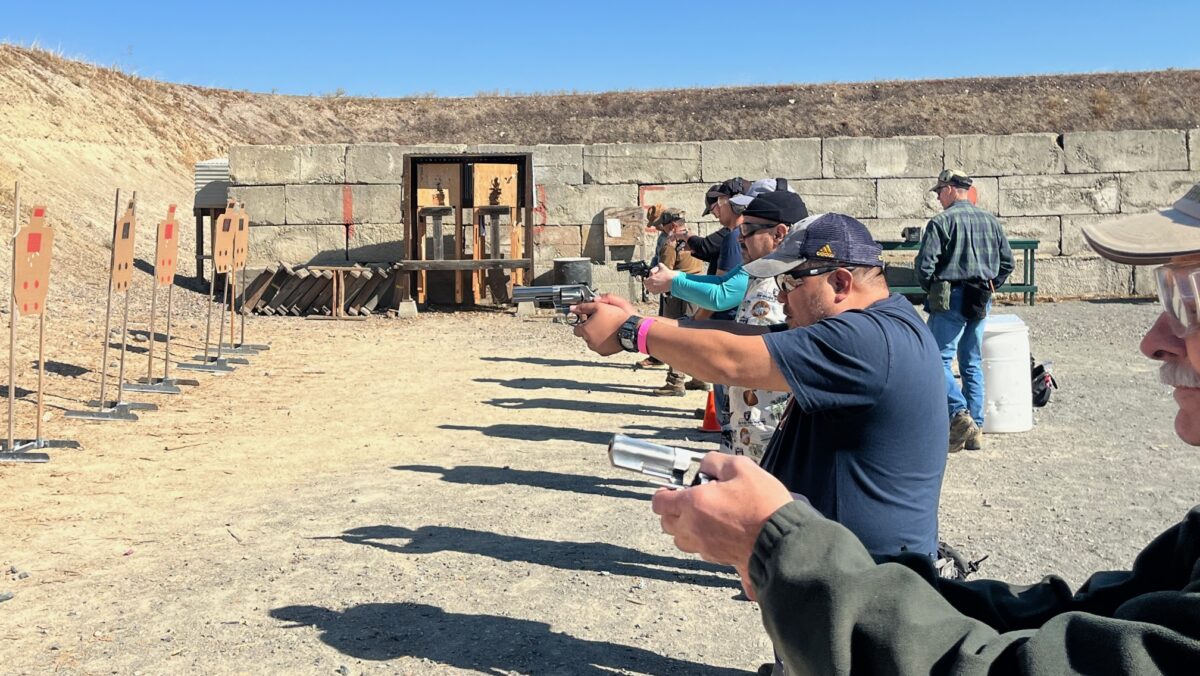Last weekend I taught a Defensive Revolver class, hosted by LMS Defense, and was very pleased to have some RevolverGuy readers join us for the training!
I thought the class went great and I really enjoyed working with LMS Defense owner Josh Jackson, and with all of our excellent students, who did a super job, throughout. I’m happy that LMS Defense is planning to schedule another class in 2024, because I’d enjoy doing it again.

Objectives Met
I won’t bore you with the details of the curriculum, but I will say that the training was designed to address and incorporate Mindset, Tactics, and Decision Making as essential elements. We spent plenty of time on Skill Development and Equipment as well, but I wanted to emphasize that the “software” is more important than the “hardware,” when it comes to personal defense.

I also wanted the students to get used to thinking and communicating with a gun in their hand, because the real world demands those skills. I think everyone enjoyed the class and got a lot out of it, but I’m biased, of course. Hopefully some of the attendees will chime in with more objective reports in the comments, below. ; ^ )
Hardware
I know lots of you are very interested in the hardware aspect, so I’ll try to summarize what the students brought, with the understanding that I was more focused on the shooters than their equipment. Here’s a few odds and ends from the class, as I remember them, for the Gearheads:
-
-
-
We had nine students total in the class, with just one left-handed shooter–the only one of us in his right mind! ; ^ )
-
Smith & Wessons edged out Rugers in the class, five to four, not counting the staff’s guns;
-
We actually had a Korth (!) in class. I’ve seen them in trade shows, but this was the first time I’d seen one out on the range. Yes, he’s one of us—a RevolverGuy reader (and a darned good shot, too);
- Guns used:
-
-
-
-
-
-
-
Korth Carry Special – (1). A .357 Mag, but shot with the optional 9mm cylinder installed;
-
Ruger SP101 – (1). A 3” version;
-
Ruger LCR – (2). Both were .357s, my preferred model. Factory stocks on one, and Hogue G10s on the other;
-
Ruger Speed Six – (1). This was a second gun, used by one of the SP101 shooters for the afternoon session. Yes, I was drooling over it!!
-
Smith & Wesson 19 – (1). No lock! More drooling!! Pachmayr Gripper stocks;
-
Smith & Wesson 36 – (1). Another from the good old days, before the lock. Splinter stocks. I suspect it had a long service record as a LE backup/off duty gun;
-
Smith & Wesson 340 – (1). With VZ Grips, I think?
-
Smith & Wesson 686 – (1). This one was a 4” gun. I think it might have worn rubber Hogues;
-
Smith & Wesson 686+ – (1). This one was a 6” gun. Again, I think it had rubber Hogues;
-
Smith & Wesson 640 and 642 – Staff’s guns. Boot grips, Kydex AIWB holsters, fed with HKS loaders and inline strip loaders;
-
-
-
Outside of the Korth with the 9mm cylinder, everyone was shooting .38 Special ammo. Winchester White Box 130 FMJ seemed to be the most popular ammunition used by the students;
-
-
Note: Since the CA market is running 70 to 80 Cents per round for “cheap” .38 ball ammo these days, I was judicious about burning up the live stuff, and we only shot about 150 rounds, total. However, each student was required to bring two cylinders’ worth of dummy ammo, and they got LOTS of valuable reps using the inert rounds. I think the mix of dry and live fire allowed us to meet our training goals without breaking the bank, and it also prevented the shooters from getting fatigued too early (nobody wants to shoot 400-500 rounds in one day with a snubby). There was no loss in training value with the dry fire, from my perspective. In fact, I think the training was enhanced by it, as shooters could focus on the manipulations without the distractions of noise, blast, and recoil;
-
-
-
We had about a 60-40 split in loading devices, with the inline strip loaders (Speed Strips, etc.) having the edge over round-body speedloaders;
-
-
One student used the Zeta6 J-CLIP-R loader for his Ruger LCR, which was working really well for him;
-
We had a pretty even split between HKS and 5-Star for round-body speedloaders. I don’t recall seeing any other brands. I was surprised there were no Safariland Comps;
-
About half the round-body speedloaders were carried in belt pouches (I recall one competition-style, two or three-cell, open top pouch, and another flapped, two-cell, nylon one, but don’t recall any others), and the rest were in pockets;
-
One shooter had his strip loaders in a Tuff Products pouch, and the rest were carried in pockets;
-
-
-
The class equipment requirements dictated the use of a strong side OWB/IWB or appendix IWB holster;
-
-
About 20% of the students were shooting from AIWB holsters, in addition to both staff members;
-
About 10% of the students were shooting from IWB holsters on the strong side hip;
-
The remaining majority of the students were shooting from OWB holsters on the strong side hip. Of the OWBs, one was a field holster for the 6” Model 686 (possibly a Galco DAO), about three were open top, competition-style rigs, and one was a high-ride scabbard for the Model 36;
-
We had about a 60-40 split, with polymer holsters beating out leather ones;
-
-
-
-
See You At the Next One?
When we schedule another class, I’ll be sure to advertise it here on RevolverGuy. I was really pleased to have so many readers in the class, and was humbled by how far some of them traveled to get there. I look forward to meeting more of you in person and getting the chance to train with you at a future class.

Until then, be safe, and remember—Mindset, Situational Awareness, Tactics, and Skill are much more important than Equipment, so pay attention to the important things, and keep training.


You know, with my wife agonizing over what to get me for Christmas (as if she doesn’t already know that any rattly cardboard box with .38 Spl written on it will do) it sure would be nice if I could say there’s a revolver training class coming up in Idaho…
Haha! Thanks Andrew, maybe someday. There’s a lot of extra expenses and details associated with taking it on the road, and it would require extra consideration (and a commitment from a hard working host, like Josh) before we could even begin to consider it. I’m not saying “no,” just saying, “not now.”
Besides, my Kalifornia passport is no good in Idaho . . . and I don’t blame the locals for getting nervous when they see us coming! ; ^ )
I second the motion of bringing it to Idaho! As far as your “passport” just do as they used to in the service, “don’t ask, don’t tell”…… or something like that.
As a lifelong Spud Head, I can tell you it’s not the Californian that makes us nervous….it’s the Californian Mindset that raises our hackles……
Amen, brother. That mindset is a cancer, wherever you find it. Would enjoy training with you guys up there someday!
If you’re going to Idaho you might as well swing through Oregon as well.…
Sure, kick it off with another CA class then roll up to OR and WA. We could call it the “Behind Enemy Lines Tour.”
😆
Well done, Mike!
I’m stoked that that you did this and that you guys had a good day. I hope this grows so that the generations to come realize that revolvers are quite viable as carry guns to ride the river with and are trustworthy hardware choices. Thanks for emphasizing the importance of the software aspect, too. Bravo!
Thanks Kevin, we’ve got to keep the art alive!
A trainer I know recently proclaimed that there’s no reason to carry a revolver these days, because you need a higher capacity weapon for today’s threats. Sigh . . . the struggle continues!
I think some of these trainers don’t even want to deal with a DA/SA semi-autos let alone a Revolver. If it’s not a striker fired Semi they don’t want to deal with it.
I think you’re right, Chris!
Not a striker liker, despite having trained with and carried them for years.
TDA and wheelguns for me, thank you: SIG 229s, aluminum Cobras and J-frames daily-daily.
With 1911s, big sixguns and the occasional hammer-fired .32 for dessert.
Mike,
Thanks again for hosting the class and the opportunity to meet and train with fellow enthusiasts.
What I felt was most enlightening from the class was the timed competition. That friendly exercise showed what a little stress can do; I definitely fumbled more than I’d like when using my speedloaders and showed me what I need to spend more time on.
I’ll definitely keep an eye out on future classes and keeping working on my “software”.
Thanks Elliot! The clock is my nemesis, too, so you’re not alone. Your accuracy was impressive though—you set the example for the rest of us. I look forward to shooting with you again!
Repost of the comment I left on the original announcement post:
This was an excellent class! I wasn’t surprised by the Mindset > Tactics > Skills > Equipment pyramid talk during the intro section, but I was surprised and delighted about how well that was integrated into the overall class structure. An aspect of mindset was discussed, then tactics coming from that, then the skills needed to execute that – this is where the drills came in.
The approach to drills was structured like the very best martial arts classes I’ve ever had – the pressure and complexity kept increasing, but not so fast that you just fell apart and failed, but enough to push you, and reveal where you will need to work some more.
Looking at the ammo I brought home, I believe we fired 130 rounds, but including all the dry fire in there, I probably had around 500 trigger presses or so. There was no point where it felt like we were just running up the round count – every round fired was a learning opportunity. While I know there are classes out there with several times that round count, I don’t believe that any increase would have added much – the way dry firing was integrated into the class made me realize that dry firing isn’t only a placeholder for when you can’t shoot live ammo, but is actually a training tool that can teach you things that are harder to learn with live ammo.
The safety lecture was well-done, and again, the approach to safety throughout the class was disciplined and well-thought out. In fact, “disciplined and well-thought out” might be a good summary of the whole class. Mike as a trainer is exactly what you would expect from Mike as a writer – detailed, focused, relaxed, good humored, but with no filler or sense that he’s just making it up or coasting.
My fellow students and Josh from LMS Defense (as the assistant to Mike) were also great. I was pretty clearly the least-skilled attendee there, which would be a bummer if this was a competition, but was great as a student – I probably got to learn more than anyone else. Thinking about it today, and going over my notes, I will be completely revamping my daily dry fire practice, and my next few (or many) range sessions. I have a lot to work on from this class!
TLDR; go take a revolver class from Mike if you get the chance. Highly recommended
Tyson, that’s very gracious of you and highly appreciated. I’m really glad the class was so useful for you, and excited that you got so much out of it. I think dry fire is highly underrated as a learning and teaching tool, and I’m glad that you’re motivated to do more of it. I need to stop being lazy, myself, and do more.
As another one of the participants in this class, I can’t say enough about the wealth of knowledge Mike brings to the revolver lifestyle. From gear selection, maintenance, to tactics and mindset, I definitely learned a lot. If you ever get a chance to train with Mike, I would highly recommend it.
Thanks again Mike!
It was my pleasure Matt, thank you for the kind words. I had a great time working with you in class, and look forward to the next time we shoot together!
You know,
There is no need to worry about your passport in Ohio: anyone over 21 who can legally own a handgun can carry concealed. And I, a Californian, was welcomed here. Just something to think about.
Thanks pal! You mean there’s still room out there in America for me? Hallelujah!
Cali is quite a ways. Can I get you to Illinois next?
Illinois is quite a ways too, Lee. 😁
I’d love to visit all of you guys in your own backyard, but the added difficulties and costs make it more challenging to “take the show on the road.” If you’ve got a dozen buddies willing to pay the tuition, and a good range host, that’s a good starting point for a discussion . . .
I’d pay tuition… Wish I had land to host
Hello,
Along with Elliot, Tyson and Matt, I was one of the students who attended Mike’s Defensive Revolver course. I’ve taken several handgun classes in the past but this was my first revolver focused course. Prior to this, I’ve perused Mike’s website, read a few books (Ayoob, Cunningham) and watched Youtube videos as educational resources. As we’ve always heard, these cannot substitute participating in a class, while being monitored under the watchful eyes and guidance of an instructor/SME (subject matter expert).
Mike has a very logical and detailed approach as to how he presented the skills, techniques and lesson points which I very much appreciated. There were many instances where Mike explained topics (grip, finger placement, etc) but were shared in a different manner or perspective that helped ignite the mental lightbulbs. There were many revolver specific techniques that I had not been exposed to before (single cartridge loading technique under pressure); by the end of the day I realize that the Art of the Defensive Revolver and this knowledge needs to continue being shared. Also, I appreciated the use of dry fire and dummy ammunition to help offset the cost of .38spl ammunition.
There’s a lot of information shared in the course and I’m still going through the pages of notes that I took throughout the day, covering mindset, marksmanship fundamentals, admin loading/unloading, emergency reloading and many others.
In the end, I thought the class and Mike were both great, as well as all of the fellow students. For those who want to learn more about the revolver and how to increase your effectiveness with it then I would recommend attending Mike’s next Defensive Revolver course.
Thank you Sir! I appreciate your exceptionally kind words about the class and I’m really pleased that I was able to approach familiar topics from a new perspective that was helpful to you. You take a lot of notes, like I do when I’m at training, and I was glad to see you filling up the pages in your book. That will be a great resource for you later on, and it was gratifying to see that you felt the information was worth recording.
Thanks for being such a conscientious student and making the class so enjoyable. I look forward to training with you again! If you ever get tired of shooting that Combat Magnum, you know who to call first! 😁
A bit surprised to see no GP100s represented.
Me too, Wayne. I thought I might see one, but only saw SP101s and the Six.